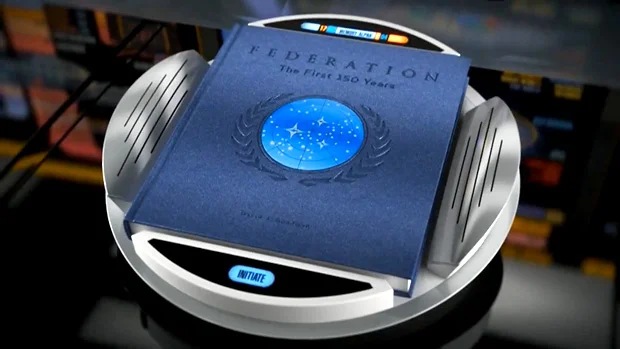by Matthew Rushing
Packaging and Display
The package arrives in a large box. When opened, it reveals another box inside. This is the beautiful box that holds the LCARS stand and the book itself. Immediately, this sets this reference book apart from all others that have come before it. Even before everything is out of the box, one is left marveling at the presentation of this product.
As the box is finally opened the finished product is revealed. It is securely fastened to the base so that the cover arrives undamaged. The only flaw in the design is this: The book rests on a circular base with a raised section in the middle and two extending shelves from top and bottom holding it up. The plastic packaging keeps the book from moving while in transit, but it also presses down on the book, leaving it bowed downwards and leaving the cover slightly bent. This is not enough of a distraction from the overall presentation, but is does merit a mention.
The book and LCARS stand itself are much bigger than anticipated. Sitting on a table, desk or shelf, they make a superb display for any Star Trek fan. The bottom LCARS can be activated to light up the stand on the top and bottom; audio from Admiral Hikaru Sulu introduces the book, as well as Memory Alpha.
With the quality of the packaging and the display of this book, minus the minor flaw, it receives a 9 out of 10 for this first section.
Art
One of the true joys of this book is the artwork. There are beautiful pictures of starships and starbases, propaganda posters and historical documents. Each one of these has been created with care and adds to the feeling of authenticity as one reads through Federation history. Some of these pieces should be sold on StarTrek.com as wall or office hangings; they are that good. The art also receives a 9 out of 10.
Extras
The book comes with six different extras in an envelope on the back inside cover. The first of the extras is a letter from David Goodman about the addendum for the 75th anniversary edition of this book. Hes give the background for each piece that has been added to this edition.
The second extra is a schematic for the U.S.S. Enterprise from Starfleet Command. It is from project supervisor Matt Jeffries and contains his signature. The Enterprise on the schematic is Pike’s from “The Cage.” This would look very nice framed. The only downside is that it is only in black and white and not the color that is displayed below.
Also included is a translated letter from the original Trill about their membership into the Federation. The letter discusses whether or not the Trill will make public their nature as a symbiotic lifeform. It’s interesting looking at the Trill from this early angle, where they express worry about how other races will see them.
The last letter included in the extras is from cadet Kirk to his mother. He talks about his experience with the Klingons on Axanar. The seeds of his distrust for the Klingons are fully on display. He writes about witnessing their cruelty and expansionism firsthand and sees Starfleet as the only hope for holding them back.
One of the highlights is the envelope that belonged to Zephram Cochrane. It contains his original handwritten speech for the groundbreaking ceremony of the warp 5 complex. It is funny to note that the envelope is from the Internal Revenue Service with the stamp “Past Due” on the front, to which Cochrane has written underneath, “To Hell With Them!!”
Lastly, included is an x-ray of a Trill. It shows the anatomy of a Trill and where the symbiote resides inside. Fans now have a definitive look at the Trill.
Each of these extras is well-produced and adds something special to this book. The look and feel makes this history feel completely real. The extras receive a 7 out of 10.
Text
All of these extras would not worth as much unless the history given is worth reading. Luckily, Goodman did not hold back. This is not an exhaustive history of the first 150 years; It is more a snapshot of the most important moments in the formation of the Federation. A question that is finally answered for fans is the reason why the Federation has such a human-centric nature and why humans dominate its affairs. The answer makes sense, given all that is known about the pre-Federation days and Earth’s own history.
Goodman gives a great picture of the importance of Archer and his crew and the effect they had on the galaxy from the moment the NX-01 left spacedock. He then strings together the most important moments in Federation history, giving many background details that have never been revealed fans. Each of them shines light on some of the most memorable adventures of Trek’s favorite characters and crews. The text receives a 9 out of 10.
Conclusion
This is certainly worth the investment for any fan. From the display, to the artwork and extras, to the story of the Federation from Cochrane’s warp flight ,to the eulogy for James T. Kirk, it is a sheer delight. David Goodman has created something that should please every Star Trek fan who wants to know more about the beginning days of the United Federation of Planets. Overall the score for this book is a 9 out of 10.







